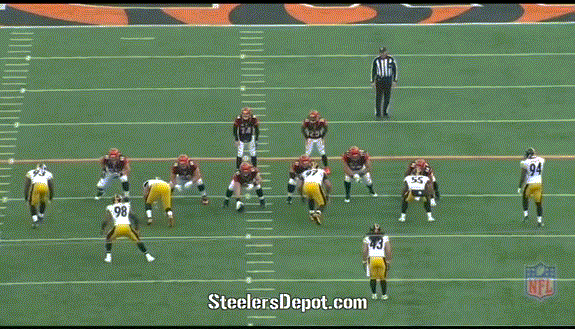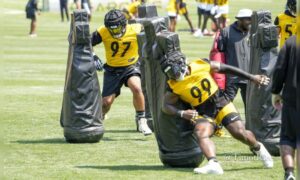Rookie Stephon Tuitt made his first career start last Sunday against the Cincinnati Bengals, after serving in a limited capacity for most of the first 12 games of his career. Presumably, he will also start the last three games of his rookie season, all but cementing his place in the starting lineup to begin his sophomore season.
The Pittsburgh Steelers are hopeful that Tuitt can pair with Cameron Heyward as bookend defensive ends along the offensive line the same way Aaron Smith and Brett Keisel were so successful together for a period of years. That is what they were drafted for, after all, with two premium picks.
While he didn’t necessarily have a dramatic impact during his first start, it’s certainly noteworthy just how much he played in the game, logging 57 of the team’s 65 defensive snaps, when his previous career high in snaps was under 30. He, in fact, stayed on the field with greater frequency than even Heyward. But how exactly did he perform?
He didn’t exactly have any real egregious errors that opened up gashing running lanes, as had happened a few times in his previous games, but he was not perfect. On the Bengals’ second play of the game, for example, he was pushed upfield beyond the play by Andrew Whitworth, who was playing right tackle on the play, along with a chip from the right guard. The play gained four yards on second and three.
He showed much better gap discipline on a running play later on the first quarter as he gained separation from the right guard, forcing the running back inside, where he was met by a quartet of Steelers defenders.
Pittsburgh opened the second half in the nickel, and the first play concluded in a three-yard quarterback sack by Heyward. But Tuitt helped make it happen. While he failed to get much initial push over the right tackle at the snap, he eventually was able to position himself well enough to slip into the backfield and get Andy Dalton on the run, right into Heyward’s arms.
He also put together a good pair of snaps on the series in which Dalton fumbled the ball off his running back’s hip. He showed good gap discipline on first down, and then made sure to get around the ball after it was on the ground on the following play, diving into the pile and making sure his team had it.
Midway through the fourth quarter, of course, Tuitt had a bit hit on Dalton that caused him to come off the field for a snap. He and Jason Worilds executed a stunt that saw the defensive end bull rush the right tackle before cutting inside, laying Dalton out with a helmet to the sternum. He said after the game that it was his favorite play.
Though the game was very much already in the Steelers’ control, Tuitt showed excellent awareness and athleticism on a third down and eight play with Jason Campbell at quarterback. While he was working to the outside of the right guard, he spun upfield when he saw the quarterback scramble out of the pocket and was able to bring him down by the ankle for a short gain, preventing a first down and forcing the Bengals to punt.












